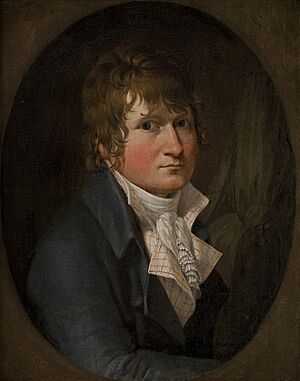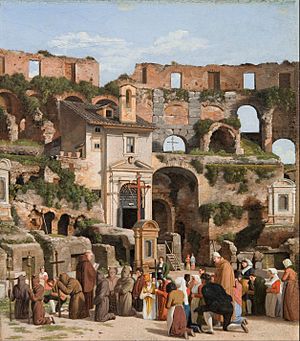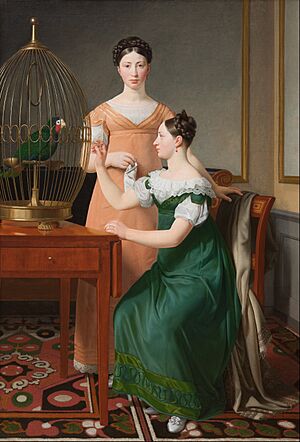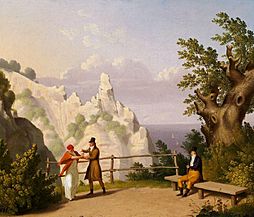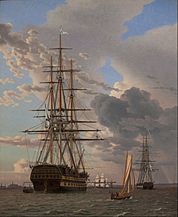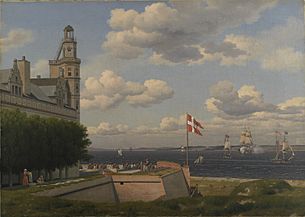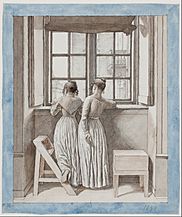Christoffer Wilhelm Eckersberg facts for kids
Quick facts for kids
Christoffer Wilhelm Eckersberg
|
|
|---|---|
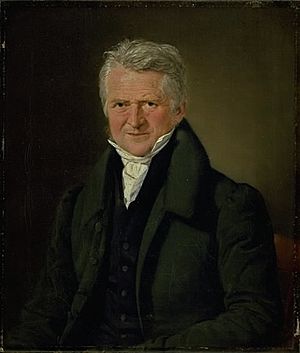
Christian Albrecht Jensen, The Painter C. W. Eckersberg, 1832
|
|
| Born | 2 January 1783 Blåkrog, Denmark
|
| Died | 22 July 1853 (aged 70) Copenhagen, Denmark
|
| Resting place | Assistens Cemetery, Copenhagen |
| Nationality | Danish |
| Education | Royal Danish Academy of Fine Arts |
| Known for | Painting clouds |
| Movement | Danish Golden Age, Neoclassicism |
Christoffer Wilhelm Eckersberg (born January 2, 1783 – died July 22, 1853) was a famous Danish painter. He was born in Blåkrog, which is now part of Aabenraa Municipality in Denmark. Eckersberg helped start a special time in art called the Golden Age of Danish Painting. Because of his big influence, he is often called the "Father of Danish painting."
Contents
Christoffer Wilhelm Eckersberg: Father of Danish Painting
Early Life and Art Training
Christoffer Wilhelm Eckersberg was born on January 2, 1783. His father, Henrik Vilhelm Eckersberg, was a painter and a carpenter. His mother was Ingeborg Nielsdatter. When Christoffer was three, his family moved to Blans. He loved drawing the nature around him. He also enjoyed sailing in his father's boat.
After finishing school, he began learning to paint. His first teacher was Jes Jessen in Aabenraa. This was from 1797 to 1800. At age 17, he continued his training in Flensborg. But his main goal was to join the Royal Danish Academy of Art in Copenhagen.
Studying at the Academy
Eckersberg made many good drawings and paintings during his training. He saved some money and got help from people who liked his art. He arrived in Copenhagen on May 23, 1803. He was accepted into the Academy for free that same year. There, he studied with famous artists like Nikolaj Abraham Abildgaard.
He quickly improved his skills. He painted historical scenes, portraits, and landscapes. He also worked hard to earn money. He made drawings for copperplate etchings. In 1809, he won the Academy's big gold medal. This was a very important award.
He was promised money to travel after winning the medal. But he did not get the money until 1812. On July 1, 1810, he married E. Christine Rebecca Hyssing. They had a son named Erling Carl Vilhelm Eckersberg. Erling later became an engraver, just like his father.
Student Travels Abroad
Eckersberg really wanted to travel. He wanted to learn more about art. He also wanted to get away from his marriage. So, he found other ways to get money for his trip. On July 3, 1810, he left Denmark. He traveled through Germany to Paris with a friend.
Learning in Paris
In Paris, he studied with neoclassicist artist Jacques-Louis David. This was from 1811 to 1812. He became much better at painting people. His teacher told him to paint from real life and old artworks. This helped him find "Truth" in his art. In Paris, he became good friends with his roommate, Jens Peter Møller. He also befriended the engraver Johan Frederik Clemens.
Life in Rome
After two years, he traveled to Rome. He continued his studies there from 1813 to 1816. He worked on improving his history paintings. He also enjoyed painting small scenes of local life. He lived in Rome for three years. Many artists were there, and Bertel Thorvaldsen was a leader among them.
Eckersberg and Thorvaldsen became close friends. Thorvaldsen was a loyal friend and gave good advice. In 1814, Eckersberg painted a great portrait of Thorvaldsen. This painting was given to the Academy of Art. Eckersberg loved living in Rome. The bright southern light there greatly affected his art. He created many beautiful works during these years. These included many amazing landscape studies.
His marriage ended while he was away. He returned to Denmark on August 2, 1816.
Becoming a Professor
Soon after returning, Eckersberg joined the Academy. He was asked to paint a scene from Norse mythology for his admission. It was about the Death of Baldur. On February 8, 1817, he married Elisabeth Cathrine Julie Juel. She was the daughter of Jens Juel, a painting professor. They had six children together. Elisabeth died in 1827.
Eckersberg became a member of the Academy in October 1817. He was named a professor in 1818. He took over the position that was open after Nikolaj Abraham Abildgaard died. The Academy waited for Eckersberg to return from his travels. They wanted him for the job.
A year after his wife Elisabeth died, he married her sister. Her name was Susanne Henriette Emilie Juel. They also had several children.
He was the director of the Academy from 1827 to 1829. Later in life, his eyesight got worse. He had to stop painting. He died in Copenhagen from cholera on July 22, 1853. He is buried in Copenhagen's Assistens Cemetery.
Eckersberg's Artworks and Influence
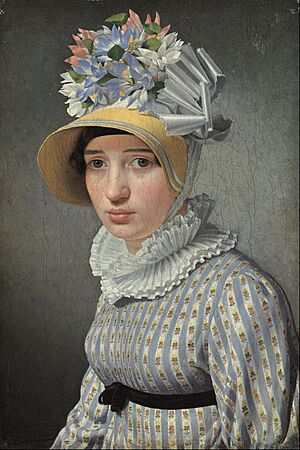
Eckersberg was asked to paint many historical scenes for Christiansborg Palace. He also painted altarpieces for churches. His most famous works are portraits of people from Copenhagen's middle class. One example is the "Nathanson family picture" from 1818. He also painted an official portrait of King Frederick VI. Even though he was good at portraits, he did not paint them for long. Other artists like Christian Albrecht Jensen were more popular then.
Marine paintings were another type of art he loved. He had a great passion for ships. At age 56, he sailed around the Skagerrak, the Kattegat, and the North Sea. He even sailed as far as the English Channel. Sailing on the open sea changed his marine paintings. Before, they were calm. Now, they showed more movement and waves.
In 1819, the Navy allowed him free access to the Copenhagen Naval Station. This let him see many ships, which he loved to paint. He could also observe sailors. This helped him choose models for his paintings about ancient Greece or Rome.
His biggest impact was as a professor at the Academy. He made teaching more exciting. He took students outside to paint from nature. This was new for Danish art. He also encouraged students to develop their own unique styles. This led to many different kinds of art.
He became very interested in perspective because of his marine paintings. He wrote a book about it in 1841. It was called Linear perspective used in the art of painting. He also taught classes on this topic. He made some etchings that showed everyday life. These combined his observations with classic art rules. This helped shape how Golden Age painters showed common life.
There is a self-portrait of him from 1803. Bertel Thorvaldsen made a sculpture of him in 1816. And Wilhelm Marstrand painted his portrait in 1836.
Eckersberg's Students
Many famous artists learned from Christoffer Wilhelm Eckersberg. Some of his students include:
- Wilhelm Bendz
- Ditlev Blunck
- Carl Dahl
- Christen Dalsgaard
- Anton Dorph
- Dankvart Dreyer
- Heinrich Eddelien
- Julius Exner
- Lorenz Frølich
- Peter Gemzøe
- Johan Vilhelm Gertner
- Hans Jørgen Hammer
- Constantin Hansen
- Frederik Theodor Kloss
- Albert Küchler
- Christen Købke
- Vilhelm Kyhn
- Emanuel Larsen
- Christine Løvmand
- Wilhelm Marstrand
- Anton Melbye
- Adam August Müller
- Emil Normann
- Fritz Petzholdt
- Jørgen Roed
- Martinus Rørbye
- Carl Frederik Sørensen
- Adolph Friedrich Vollmer
Gallery
- Paintings by Christoffer Wilhelm Eckersberg
See also
 In Spanish: Christoffer Wilhelm Eckersberg para niños
In Spanish: Christoffer Wilhelm Eckersberg para niños
- Art of Denmark
- List of Danish painters


